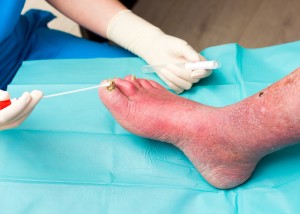-
Stasis dermatitis: Signs and symptoms
Posted on December 14, 2015 by Vein Admin in Associated conditions, dr joseph magnant, varicose veins Most of us think of varicose veins as a singular issue, but when left untreated not only are they unsightly but they can be very painful and lead to a whole wide range of further medical complications.
Most of us think of varicose veins as a singular issue, but when left untreated not only are they unsightly but they can be very painful and lead to a whole wide range of further medical complications.One off shoot complication of poor circulatory performance can be stasis dermatitis. Stasis dermatitis is a painful and unsightly condition caused by long standing untreated venous insufficiency. Poor circulation can lead to ulcerations which may spread the length of the lower leg and even extend to the feet as the lower leg is typically where blood clots form.
Stasis dermatitis is essentially an inflammation of the skin. As blood pools and collects, pressure builds up in the capillaries. This in turn will cause edema (leg swelling). Skin becomes hot and inflamed, and often itchy, scaly and red. In extreme cases open sores may develop that do not readily heal.
What are the risk factors?
- Elevated blood pressure
- Untreated venous insufficiency
- Being severely over weight
- Varicose veins
- Lower leg injury
- Multiple pregnancies
- Congestive heart failure
- Kidney failure
- Deep Vein Thrombosis
The skin not receiving proper blood flow may eventually thicken, harden, become lumpy or turn dark brown. This is called lipodermatosclerosis. In the final stages of stasis dermatitis, your skin breaks down and ulcers or sores, form.
Stasis dermatitis is usually the result of a chronic illness, so it’s difficult to prevent if you’re already ill. However, you can reduce your risk by preventing the swelling in your legs that causes it. You can also lower your risk by exercising as it increases circulation and lowers body fat carried.
How is stasis dermatitis treated?
Treating the underlying condition is the most important aspect. Consult with a vein specialist. Additionally to treat the skin your doctor may recommend:
- Avoiding long periods of either standing or sitting still
- When you do sit, prop feet up when possible
- Compression stockings should be worn to help support the veins
- Wear soft loose fitting clothes that will not rub and irritate the skin further
- Topical steroid creams may be prescribed
- Antibiotics may also be prescribed
If left untreated
- chronic leg ulcers may form
- You may develop a bone infection
- Bacterial skin infections, such as abscesses or cellulitis, may occur
- Permanent scarring is likely
As soon as you notice symptoms or feel something may not be right please visit your doctor. The sooner you begin to treat vein issues the more successful the outcome in resolving them. Over time, if left untreated, these changes can become permanent.
If you are experiencing vein issues and would like to be evaluated in order to achieve the most optimal outcome we invite you to visit www.eveinscreening and start with a FREE evaluation. From there Dr. Joseph Magnant will work with you and get you on track to the best vein health possible.





